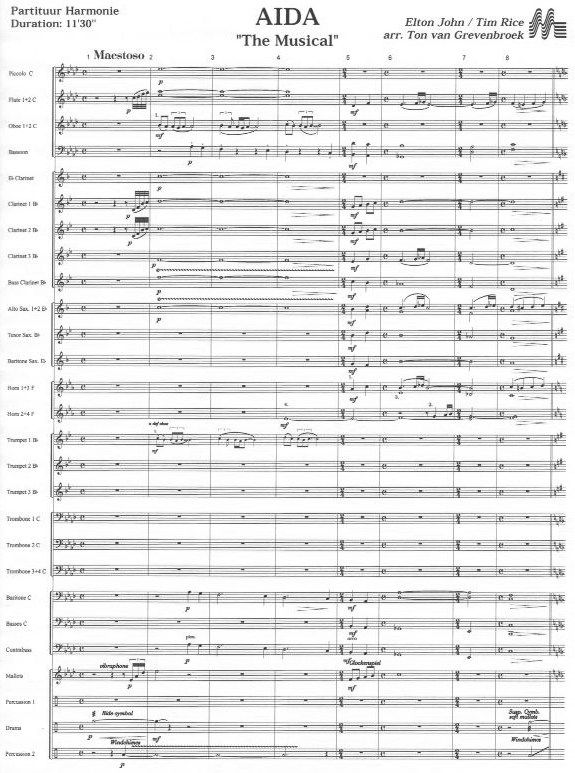

Facing death, Radames swears he will search for a hundred lifetimes to find Aida again. Unable to pardon them, Amneris convinces her father to let Aida and Radames die together – an act of mercy for two people she has come to love – and the lovers are buried alive beneath the sands of Egypt. When Amneris’s father, the reigning Pharaoh, discovers their forbidden love, he sentences Aida and Radames to death. Even so, the two succumb to their feelings. Aida’s loyalty to her people causes her to question her growing affection for Radames, who feels he is betraying Amneris and his family. As Aida and Radames come to know each other, they fall in love. His father, Zoser, has arranged for him to marry her so that he can have greater power in Egypt. Radames sends Aida to serve Amneris as a handmaiden. A statue of Amneris, a female Pharaoh, comes to life and transports the audience to ancient Egypt, where Egyptian army captain Radames is returning from an expedition through the land of Nubia, where he has captured the majestic Aida, the daughter of the Nubian king. In the Egyptian wing of a modern art museum, a man and a woman touring the exhibit catch each other’s eyes. Love, power, and destiny collide in a timeless tale retold in a contemporary idiom. The original Broadway production ran for a total of 1 852 performances. The musical features a book by Linda Woolverton, Robert Falls and David Henry Hwang, and a score featuring music by Elton John and lyrics by Tim Rice. A children’s storybook adaptation of the opera by Leontyne Price inspired this retelling of the opera, which Disney originally intended to produce as an animated film. This makes it a perfect choice for those who cherish classical opera productions.Based on Antonio Ghislanzoni and Giuseppe Verdi’s opera of the same name, Aida premiered on Broadway on 23 March 2000, following developmental runs in Atlanta and Chicago. Italian musicologist and music critic Massimo Mila believes that Aida is an opera that is stage directors and designers find hard to modernise without compromising on the work’s splendour. To think that this grand work, despite being untypical for Verdi, was written and orchestrated in just four months. The splendid spectacle still attracts today’s audiences with its extraordinary score, fantastic sets inspired by the ancient world, exquisite duets, in particular the final one sung by Aida and Radamès, and numerous crowd scenes featuring a chorus and extras. Having opened in Cairo on 24 December 1871 and less than seven weeks later in Milan’s La Scala, the opera began a triumphant march across the world’s opera houses. Love that goes against the raison d’état as defined by priests leads to Aida’s demise as she suffers the consequences of her beloved’s choices.

The four-page prose scenario was devised by well-known French Egyptologist Auguste Mariette-Bey, yet the actual libretto was written in verse by Antonio Ghislanzoni.Īll of the efforts produced a moving musical tale of love between Aida, a slave at the Pharaoh’s court, and Egyptian military commander Radamès who chooses his heart over his country and his Gods, becoming a tragic protagonist not unlike those in Sophocles plays. Paradoxically, although he rejected the style of grand opera, Verdi decided to create a spectacular large-scale work that would attract huge crowds. That is perhaps why the failure of Un ballo in maschera, whose Naples premiere had not taken place after the composer rejected changes introduced by censors, the frigid reception given to the first version of La forza del destino by the critics and audiences, and the publication of the famous To Italian Art - Sapphic Ode with Glass in Hand by Arrigo Boito who failed to appreciate Verdi’s work – contributed to the birth of this great yet singular opera by Verdi. Having accepted this rather usual commission, Verdi had to work out a compromise with himself, leaving aside the principles he had formulated and applied when writing all his previous operas.
Aida musical series#
Eventually, however, possibly prompted by a series of unfortunate events and a read of a prose scenario for the opera provided by Camille du Locle, Verdi committed himself to the task. At first the composer initially refused the offer despite a hefty fee. In 1870 Giuseppe Verdi was approached with the request to write an opera for the new Khedivial Opera House in Cairo, erected on the orders of Isma’il Pasha, the viceroy of Egypt.


 0 kommentar(er)
0 kommentar(er)
